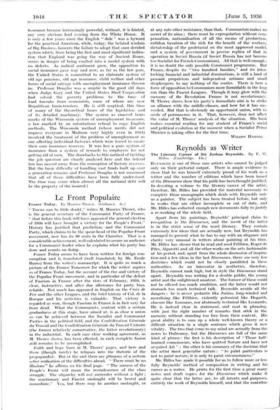Reynolds as Writer
The Literary Career of Sir Joshua Reynolds. By F. W. Bilks. (Cambridge. 15s.)
REYNOLDS is one of those rare artists who cannot be judged only on their pictorial output. There is ample evidence to show that he was himself extremely proud of his work as a writer and the number of editions which have been issued of the Discourses show that his pride has been thought justified. In devoting a volume to the literary career of the artist, therefore, Mr. Hilles has provided the material necessary to complete those monographs which deals with Reynolds only as a painter. The subject has been treated before, but only in works that are either incomplete or out of date, and Mr. Hines has collected enough new documents fully to justify a re-working of the whole field.
Apart from his paintings, Reynolds' principal claim to recognition is the Discourses, and the merit of the latter is in the strict sense of the word literary. They contain extremely few ideas that are actually new, but Reynolds has managed to present what he has to say with an elegance and clarity very unusual in writers about painting at his time. Mr. Hilles has shown that he read and used Felibien, Roger de Piles, Algarotti and all the other works on the arts fashionable at his period, and, apart from the whole discussion of inspira- tion and a few ideas in the last Discourses, there are very few doctrines which could not be closely paralleled in these authorities. As an innovator in aesthetics, therefore, Reynolds cannot rank high, but in style the Discourses stand apart. Reynolds was writing for a double public, the young artist and the enlightened amateur. The former of these could not be offered too much erudition, and the latter would not stomach too much technical talk. Reynolds avoids all the dangers : he is never pedantic like Junius, long-winded and moralising like Felibien, violently polemical like Hogarth, obscure like Lomazzo, nor abstrusely technical like Leonardo. He is instead clear in statement, and neat in phrasing, with just the right number of remarks that stick in the memory without standing too free from their context. His great ability is to sum up a whole well-known theory or a difficult situation in a single sentence which gives it new vitality. The two that come to my mind are actually from the notes to Dufresnoy, but the Discourses are full of the same kind of phrase : the first is his description of "Those half- learned connoisseurs, who have quitted Nature and have not acquired Art " ; the other is his summary,of the doctrine that the artist mustgeneralise nature : "to paint particulars is not to paint-nature, it is only to paint circumstances."
Mr. Hilles has made it possible for us to follow more or less fully Reynolds' Method of composition in writing and his career as a writer. He prints for the first time a great many notes and draft copies for the Discourses which make it quite clear that the latter are, to all intents and.purposes, entirely the work of Reynolds himself, and that the contribu-
tion of Johnson cannot have been more than the polishing ot a phrase here and there. This particular red herring is now finally disposed of. In addition, by bringing together a fairly complete list of the books' Which Reynolds seems to have read and used for his different literary works, Mr. Hilles has made his various debts clearer, though at the same time be emphasises the fact ,that Reynolds was not a plagiarist, but fully digested all that he read. Courtenay's description of his conversation really says the last word on this subject : " If his ideas were not always new, they were often set off by liveliness of imagination." Mr. Hales has brought all this matter together in a form which gives a coherent picture of Reynolds, not only as an individual but even more asa member of a group in which his opinion in literary- 'matters was received with respect and his taste in all intellectual questions deeply admired. Considered from this point of view, Reynolds has a certain distinction that is lacking if he is thought of as a pure painter.
The following small corrections and additions might be made : the French name of Junius was du Jon, not du John (p. 123) ; it was Roger de Piles and not Felibien who wrote the Dissertation sur les Ouvrages des plus Fanieux Peintres (121). I should suggest that the Essay on Design mentioned on page 120 is Gwyn's work of 1749; that the Voyage Pittoresque de Paris on page 121 is almost .certainly that by •Dezallier d'Argenville ; and that the History of Painting on page 120 is perhaps the 1699 translation of Monier's Histoire des Ans. To the list of presentation copies of Reynolds' Discourses, the following may be added front the collection of Mr. Victor Rothschild : with inscriptions to Lord Scarsdale, the third state of the first, the third and the fourth. The copy of the fifth, dedicated to Whitefoord, mentioned by Mr. Hilles, is now in the same collection, as also are Reynolds' copy of Martial referred to on page 116, Adam Smith's copy of the 1778 col- lected edition of the Discourses, and finally Reynolds' copy of I logarth's Analysis of Beauty. ANTHONY BLUNT.















































 Previous page
Previous page